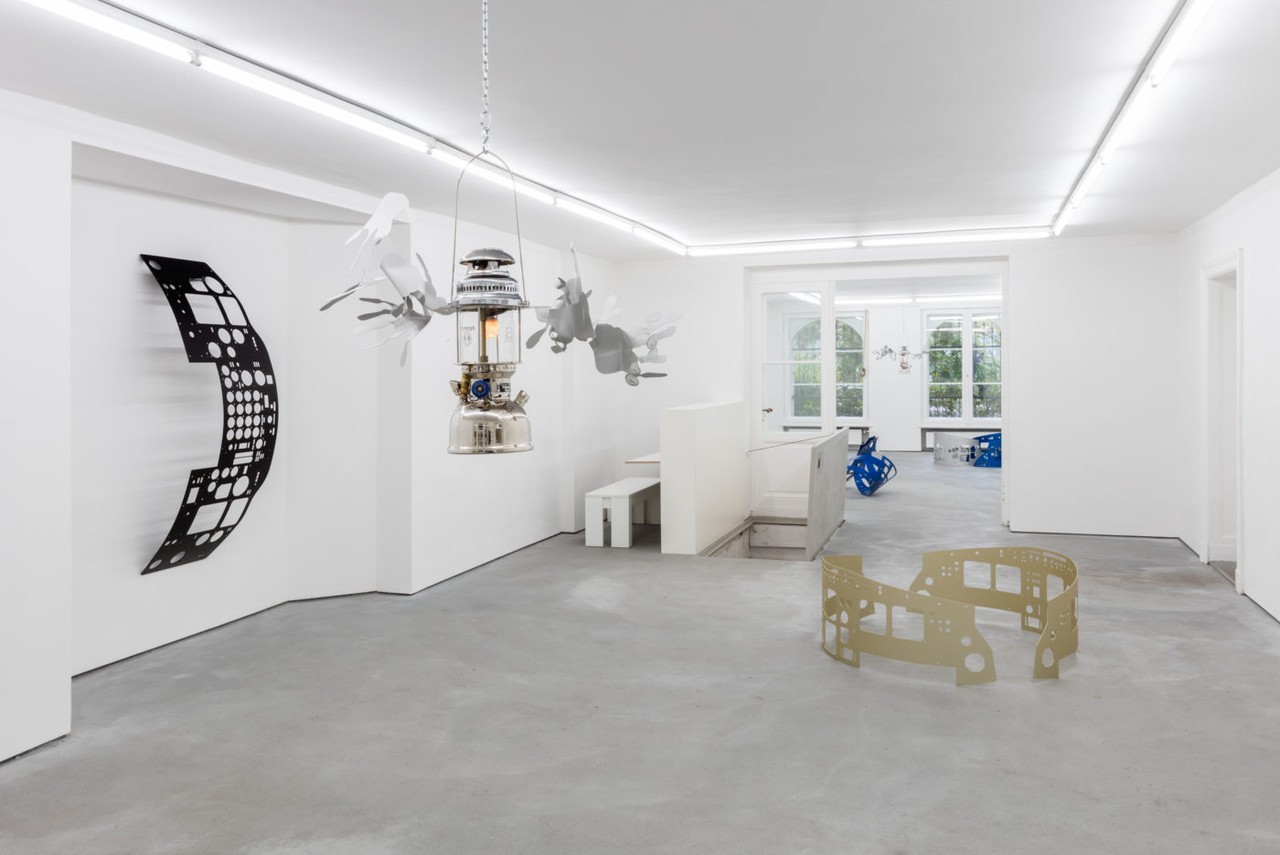Nicolas Pelzer
Collider Body
09 Sep - 21 Oct 2017
NICOLAS PELZER
Collider Body
9 September – 21 October 2017
Future Gallery is proud to present Collider Body by Nicolas Pelzer. This is the third solo show by the German artist at the gallery. The exhibition title originates from a function tag inside the 3D software Cinema 4D. In the program, Collider Body is a physics simulator which allows one 3D object to interact with other objects in 3D space. For this exhibition, Pelzer presents a series of laser cut anodized aluminum cockpit sculptures; two customized 20th century oil lanterns; and a 9 meter-long fabric banner installation.
Pelzer’s new series Cockpit Rule consists of laser cut cockpit frames from different types of civil airplanes. These flat armatures were bent into varying circular forms, each one with a different radius and anodized with a shimmering color coating. The cockpit silhouettes are shown without any engineering devices. The holes show where the instruments would normally be. What remains is the skeleton of a very complex and intelligent control system.
Two new iterations of Pelzer’s lamp series Evolving Masters – Lantern are on view in the main rooms of the gallery. These lamps begin with a classic 20th century oil lantern, the model and design has not been modified since its original fabrication and is still being produced today as a modern vintage object exactly as it was a century ago. Pelzer replaced the lanterns lampshade with laser cut anodized aluminum pieces. These pieces resemble the forms of foot steps and contemporary shoe prints as well as handprints of motifs that can be found in prehistoric cave paintings.
This fascination with the first man made marks continues into the large-scale satin print installed in gallery’s cellar space. Due to its enormous length, the banner connects both of the gallery’s show rooms in the subterranean space. A 3D rendered oversized scratch spans over the full length of the print. The carving was created using computer-generated imagery, which calculates physical traces of a prehistoric stone tool on an even surface. The scratches were determined by the artist however the course of motion was algorithmically calculated by the software. The surface of the scratched picture is a specular reflection emitting the color and texture of red ocher, this color was the first pigment used for the cave paintings.
In Collider Body Pelzer performs an active investigation into the increasingly autonomous nature of technology starting with prehistoric objects arriving at contemporary smart devices. The conflation of two time periods is omnipresent throughout Pelzer’s practice. His resulting propositions are hybrid objects neither new nor old but inherently a simultaneous question about both historical contexts at once.
Nicolas Pelzer (*1982, Dinslaken, Germany) lives and works in Berlin. Recent and past exhibitions include: Skulpturenmuseum Glaskasten, Marl; Extra City Kunsthal, Antwerp; Kunsthaus Hamburg, Hamburg; Kunst im Tunnel, Düsseldorf; Artsonje Center, Seoul, South Korea; Bundeskunsthalle, Bonn; Kunstverein für die Rheinlande und Westfalen, Düsseldorf.
Collider Body
9 September – 21 October 2017
Future Gallery is proud to present Collider Body by Nicolas Pelzer. This is the third solo show by the German artist at the gallery. The exhibition title originates from a function tag inside the 3D software Cinema 4D. In the program, Collider Body is a physics simulator which allows one 3D object to interact with other objects in 3D space. For this exhibition, Pelzer presents a series of laser cut anodized aluminum cockpit sculptures; two customized 20th century oil lanterns; and a 9 meter-long fabric banner installation.
Pelzer’s new series Cockpit Rule consists of laser cut cockpit frames from different types of civil airplanes. These flat armatures were bent into varying circular forms, each one with a different radius and anodized with a shimmering color coating. The cockpit silhouettes are shown without any engineering devices. The holes show where the instruments would normally be. What remains is the skeleton of a very complex and intelligent control system.
Two new iterations of Pelzer’s lamp series Evolving Masters – Lantern are on view in the main rooms of the gallery. These lamps begin with a classic 20th century oil lantern, the model and design has not been modified since its original fabrication and is still being produced today as a modern vintage object exactly as it was a century ago. Pelzer replaced the lanterns lampshade with laser cut anodized aluminum pieces. These pieces resemble the forms of foot steps and contemporary shoe prints as well as handprints of motifs that can be found in prehistoric cave paintings.
This fascination with the first man made marks continues into the large-scale satin print installed in gallery’s cellar space. Due to its enormous length, the banner connects both of the gallery’s show rooms in the subterranean space. A 3D rendered oversized scratch spans over the full length of the print. The carving was created using computer-generated imagery, which calculates physical traces of a prehistoric stone tool on an even surface. The scratches were determined by the artist however the course of motion was algorithmically calculated by the software. The surface of the scratched picture is a specular reflection emitting the color and texture of red ocher, this color was the first pigment used for the cave paintings.
In Collider Body Pelzer performs an active investigation into the increasingly autonomous nature of technology starting with prehistoric objects arriving at contemporary smart devices. The conflation of two time periods is omnipresent throughout Pelzer’s practice. His resulting propositions are hybrid objects neither new nor old but inherently a simultaneous question about both historical contexts at once.
Nicolas Pelzer (*1982, Dinslaken, Germany) lives and works in Berlin. Recent and past exhibitions include: Skulpturenmuseum Glaskasten, Marl; Extra City Kunsthal, Antwerp; Kunsthaus Hamburg, Hamburg; Kunst im Tunnel, Düsseldorf; Artsonje Center, Seoul, South Korea; Bundeskunsthalle, Bonn; Kunstverein für die Rheinlande und Westfalen, Düsseldorf.

